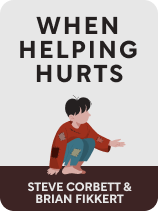

This article is an excerpt from the Shortform book guide to "When Helping Hurts" by Steve Corbett and Brian Fikkert. Shortform has the world's best summaries and analyses of books you should be reading.
Like this article? Sign up for a free trial here.
How can we reduce poverty? What is the right way to approach poverty alleviation?
In When Helping Hurts, Steve Corbett and Brian Fikkert discuss how to practically approach poverty alleviation. This includes some common problems they’ve observed with current approaches and how to design more effective interventions.
Continue reading to learn how we can reduce poverty the right way.
1. Let the Right People Craft the Approach
How can we reduce poverty? Corbett and Fikkert advise that sometimes other people or other organizations are in a better position to minister to a given community than you or your church are. If that’s the case, you should let the people who are most qualified to do the project take charge of it and either humbly ask them what you can do to help or turn your attention to a different need that you’re better equipped to meet.
The authors pose three questions to ask yourself before taking on any poverty alleviation project. If you can’t confidently answer “yes” to all three questions, don’t take the project.
1. Do you fully understand the situation, including relevant local customs and culture? If not, don’t take charge of the project yourself. Instead, let a local church in the affected area or someone else who fully understands the situation take charge, and look for ways to support them on the project, such as by donating money.
2. Are local organizations incapable of meeting the need? If they’re able to meet the need themselves, don’t intervene. The goal is to empower people to take charge of their own lives and communities. Trying to help when it’s not necessary ultimately undermines their agency—which causes harm.
(Shortform note: As we’ve discussed, Corbett and Fikkert point out that intervening—rather than letting local organizations handle a crisis—can harm aid recipients psychologically and take customers away from local businesses. Others point out that it can also harm their social and political systems by making the government less accountable to the people. This is because when an outside agency steps in to meet a need, it takes pressure off the local government to address problems that may have created or contributed to creating the need.)
3. Are you actually capable of meeting the need? In situations where outside help is warranted because the local organizations don’t have the resources or qualifications to adequately address the situation, outside help is only beneficial when the outsiders have the necessary training, qualifications, and resources. If you try to help when you don’t know what you’re doing, you’ll just get in the way.
2. Provide the Right Type of Aid
The authors explain that three basic types of aid will help reduce poverty:
Relief consists of providing immediate assistance to people in a time of crisis, such as when their homes have been demolished by an earthquake, or they’ve had to flee their homes because of war. When correctly applied, relief temporarily provides outside resources to prevent a bad situation from getting worse.
Rehabilitation consists of helping people to recover from a crisis. According to Corbett and Fikkert, rehabilitation should take the place of relief as soon as the victims of the crisis no longer need urgent material assistance to prevent their situation from worsening. A key distinction between relief and rehabilitation is that relief is characterized by giving things to people, whereas rehabilitation involves working with people to help them recover. Rehabilitation efforts should end when recovery is complete, that is, when the crisis victim has recovered to where they were before the crisis struck.
Development consists of empowering people to improve their situation beyond what it’s been in the past. Development picks up where rehabilitation leaves off. The authors assert that development should involve a two-way relationship where both the provider and receiver help each other mend their broken relationships with God, self, others, and creation.
For example, suppose your neighbor’s house was destroyed by a tornado. Letting him stay in your guest bedroom, free of charge, for a while is relief. Lending a hand as he rebuilds his house is rehabilitation. Spending time strategizing with him about how you can both be better prepared for the next tornado season is development.
Don’t Provide Relief to People Who Need Development
Corbett and Fikkert advise that it’s important to consider which of the three types of aid the community you’re trying to help actually needs and provide the right type of aid. They observe that many churches default to providing relief, but most poor people need development, not relief.
At any given time, only a small percentage of the poor people in the world need immediate relief: victims of recent natural disasters, for example. But even in the case of a natural disaster, the authors observe that by the time a church has heard about the disaster on the news, planned a charitable mission to help the victims, raised funding to support the mission, and sent a missionary team to the affected area, the need for relief is typically over. By that time the victims need rehabilitation or development.
Moreover, as the authors explain, providing relief to people who really need rehabilitation or development may only delay their progress. If they receive short-term relief but never get the rehabilitation and development that they need, then when the relief ends, their situation may become worse than ever.
3. Stop Focusing on Problems and Providing Outside Resources
Beyond providing the wrong type of aid, the other problematic approach to reducing poverty alleviation that Corbett and Fikkert observe is when aid providers start by assessing the needs of the poor community and pairing them with outside resources to develop solutions. This approach often stems from a paternalistic superiority complex, as it comes down to telling the poor: “Tell us your problems, and we’ll provide a solution.”
This approach also implicitly assumes that the poor community’s problems cannot be solved without outside resources and focuses outside attention solely on their problems. As such, it reinforces their sense of shame, inferiority, and powerlessness, making their poverty worse.
To avoid these problems, Corbett and Fikkert advise taking a different approach that involves assessing the community’s assets before their needs, as we’ll discuss next.
Assessing Assets Instead of Needs
Corbett and Fikkert recommend an approach called asset-based community development (ABCD). This approach focuses on the poor’s assets, including individuals’ unique skills and talents, as well as the community’s existing resources.
Corbett and Fikkert discuss several advantages of the asset-based approach. First, whereas a needs-based approach emphasizes what’s “wrong,” an asset-based approach emphasizes what’s “right,” which is more encouraging for all involved.
Second, an asset-based approach focuses on local resources first, thereby empowering the community and reducing the risk of developing dependence. Only when the community’s assets aren’t sufficient do outsiders offer additional resources.
Finally, using an asset-based approach can help the non-poor overcome feelings of superiority. This is because it emphasizes everything the poor have to offer, which combats the tendency to see them as helpless people.

———End of Preview———
Like what you just read? Read the rest of the world's best book summary and analysis of Steve Corbett and Brian Fikkert's "When Helping Hurts" at Shortform.
Here's what you'll find in our full When Helping Hurts summary:
- How many Christian church missions actually do more harm than good
- A look into the true nature and causes of poverty
- Suggestions for how to help the poor more effectively






